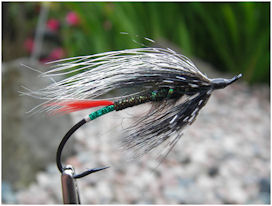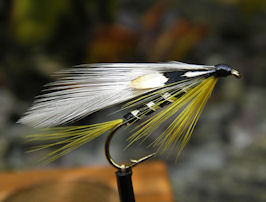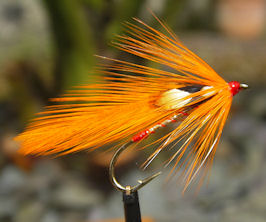|
|
|
|
|
|
|||||||||||||
|
|
|
|
|||||||||||||||
|
|
Salmonfly.Net |
|
|
|
|||||||||||||
|
|
|||||||||||||||||
|
|
Flies and Tips from Stevie Munn
|
||||||||||||||||
|
|
|
|
The Venerable Skunk  This
rendition of the famous Green Butt Skunk, a fly from North America, was tied by
a great American fly tyer, Mr. Scott Howell. Scotty, sadly, passed away in
January 2008 after a courageous battle with cancer. I had the good fortune to
count Scotty as a friend and he often sent me a few of his marvelous salmon
flies to try on my travels and on this side of the Atlantic. Luckily many of his
flies worked. Scotty shows again how established patterns can be tied with
modern materials in the Atlantic Salmon Fly tradition. Salmon and in the USA,
Steelhead Flies, were first developed in that classic tradition. This
rendition of the famous Green Butt Skunk, a fly from North America, was tied by
a great American fly tyer, Mr. Scott Howell. Scotty, sadly, passed away in
January 2008 after a courageous battle with cancer. I had the good fortune to
count Scotty as a friend and he often sent me a few of his marvelous salmon
flies to try on my travels and on this side of the Atlantic. Luckily many of his
flies worked. Scotty shows again how established patterns can be tied with
modern materials in the Atlantic Salmon Fly tradition. Salmon and in the USA,
Steelhead Flies, were first developed in that classic tradition.
Although many other styles have evolved, here is an example of how the use of modern materials can perhaps enhance classic or traditional flies. The original Skunk has been attributed to various sources. Some believe it was originated by Wes Drain for Washington's Stillaguamish River in the 1930s. Others believe it was originated in the 1940s for Oregon's North Umpqua. It has been tied in numerous variations. Whatever the case, it remains a reliable fly in the USA that has traveled well. This fly has worked on Irish rain fed rivers like the Finn, Mourne, Sixmile Water and Kells, and can be fished on the point or dropper especially in water that carries a tint of colour. Black Ghost  I
first saw this fly in the old John Veniard book,
Fly Dresserís Guide. The
Black Ghost dates from around 1927 and became one of the classic
American Streamer patterns in the 1930s. American artist and
sculptor Herbie L. Welsh is credited with the
original.
Welsh is at times also credited to be the first person to help
develop the modern day long-shank fly hook. I
first saw this fly in the old John Veniard book,
Fly Dresserís Guide. The
Black Ghost dates from around 1927 and became one of the classic
American Streamer patterns in the 1930s. American artist and
sculptor Herbie L. Welsh is credited with the
original.
Welsh is at times also credited to be the first person to help
develop the modern day long-shank fly hook.
The original Black Ghost streamer flies were first dressed on reshaped bait hooks because Welsh needed a longer hook that would be better for making smelt imitations. He started to make his own long-shank hooks which may have given rise to todayís long shank lure and streamer hooks. The original Black Ghost had a featherwing but there are also white bucktail and white marabou winged versions that work very well. This fly works when trout are taking fry or baitfish. It also works well for migratory Lough trout such as Dollaghan and like most Dollaghan flies can be deadly for Seatrout. It is a popular big trout and steelhead fly in its native land. Whiskey Fly  I
have added this fly because it has worked for me amazingly well at
times and perhaps when you would least expect it. The first Whiskey
Fly was dressed in the streamer style by Albert Whillock from
England. It is not a very old
fly compared to some and became very popular in the early 1970s
where it worked well on English stillwaters such as Grafham Water.
There, it was the down fall of many a rainbow trout. I
have added this fly because it has worked for me amazingly well at
times and perhaps when you would least expect it. The first Whiskey
Fly was dressed in the streamer style by Albert Whillock from
England. It is not a very old
fly compared to some and became very popular in the early 1970s
where it worked well on English stillwaters such as Grafham Water.
There, it was the down fall of many a rainbow trout. Orange flies are always worth a try on hot sunny days and Whillock recommends that it be fished just under the surface at a moderate speed. I myself have caught many brown trout on this fly that were feeding on daphnia - perhaps no surprise as bright flies often work well on daphnia feeding trout. It is perhaps more unusual that it works fantastically well for me when trout are taking the Caenis, the smallest of the mayfly genus and often called the ĎFisherman's White Curseí. No other fly hatch brings as many trout to the surface from July to August, but no other hatch leaves so many anglers totally flustered at times, as they watch the trout sipping down countless spents on the water. It is for me, not the size of this little upwing because we can match it with small hooks. I do have a few spents dressed on size 20 and 22 hooks that I have some success with. Itís the sheer numbers when they hatch, that is the problem. How you get a trout to take your artificial sitting among countless real flies can be at times very hit and miss and this is where the Whiskey Fly works for me. I used to keep this a secret in my local competition days but I donít often fish them now. The tactic is cast your fly in front of the feeding fish. Itís best if you can find a small pod - maybe 2 to 4 fish feeding together as they will often compete. Strip your fly back to you at a very fast pace and often this will provoke a trout into chasing your fly. It is very exciting at times to see the large bow waves just behind your fly as a trout races after it. At this point, donít slow up but keep stripping back at the same pace. Sometimes the fish will turn back at the last moment and sometimes you will be stopped by the take and the trout will be on. This is a method that works. Try it and you will thank me for it. Also like the other two flies it will take migratory Lough trout such as Dollaghan when fished in the evening in their rivers.
Irish fly tyer Stevie Munn is also a qualified fly casting instructor and guide with over 30 years of angling experience. Although he is a guide on many Irish rivers he is found most on his local river, The Six Mile Water in Co. Antrim where he is an expert on Brown Trout, Dollaghan (a Lough run Brown much like Seatrout) and Salmon.
|
|
|||||||||||||
|
|
|||||||||||||||||
Home |
About Salmonfly.Net |
Links |
Stores |
Contact the Webmaster
| |||||||||||||||||